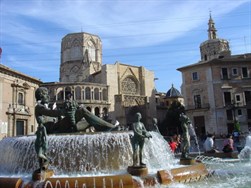Valencia
 Torn from Muslim control in 1238 by the army of James I of Aragon, Valencia lived a true golden age in the fifteenth century, with economic well-being and the cultural and artistic wealth. The most populous city of the whole Crown of Aragon, Valencia remained the seat of the viceregal court even after the union with the Crown of Castile, but gradually lost its economic prosperity. The shift of international trade to the Atlantic ocean and the prohibition of subjects of the Crown of Aragon to take part in trade with the Castilian colonies in America affected the interests of the city. Another blow to the local economy derived from the expulsion of the large community of Moriscos (1609-1614) decided by King Philip III. Suddenly deprived of almost a third of its entire population, the Kingdom of Valencia underwent a period of severe economic crisis, accentuated by the dispatch of troops and money to Philip IV to quell the revolt of Catalonia (1640-1652). With the War of the Spanish Succession (1701-1713), in which Valencia sided with Charles of Habsburg, the city lost its kingdom. The new king, Philip V of Bourbon, in fact, ordered the abolition of the Valencian Fueros (the laws came into force already in the time of James I) and the decrees of the Nueva Planta also imposed Castilian laws in Valencia.
Torn from Muslim control in 1238 by the army of James I of Aragon, Valencia lived a true golden age in the fifteenth century, with economic well-being and the cultural and artistic wealth. The most populous city of the whole Crown of Aragon, Valencia remained the seat of the viceregal court even after the union with the Crown of Castile, but gradually lost its economic prosperity. The shift of international trade to the Atlantic ocean and the prohibition of subjects of the Crown of Aragon to take part in trade with the Castilian colonies in America affected the interests of the city. Another blow to the local economy derived from the expulsion of the large community of Moriscos (1609-1614) decided by King Philip III. Suddenly deprived of almost a third of its entire population, the Kingdom of Valencia underwent a period of severe economic crisis, accentuated by the dispatch of troops and money to Philip IV to quell the revolt of Catalonia (1640-1652). With the War of the Spanish Succession (1701-1713), in which Valencia sided with Charles of Habsburg, the city lost its kingdom. The new king, Philip V of Bourbon, in fact, ordered the abolition of the Valencian Fueros (the laws came into force already in the time of James I) and the decrees of the Nueva Planta also imposed Castilian laws in Valencia.
